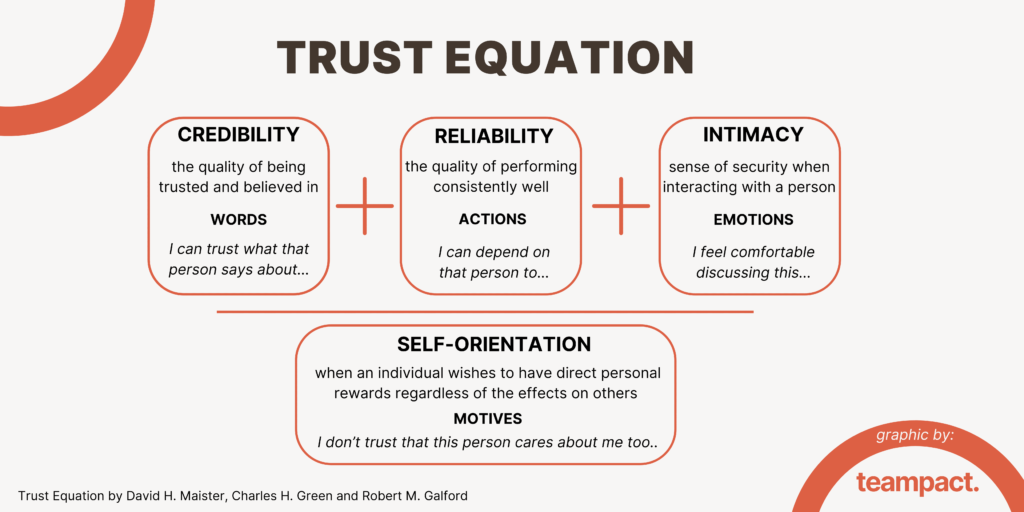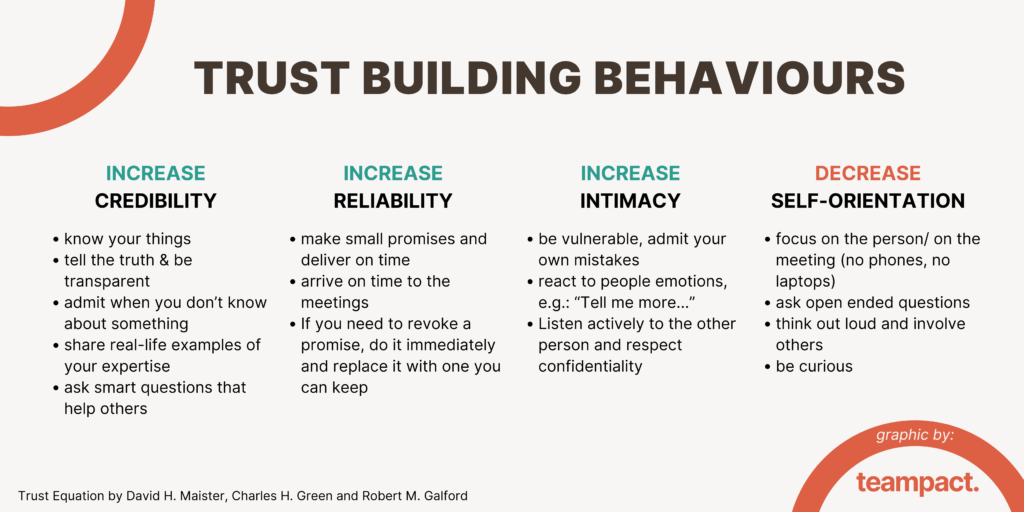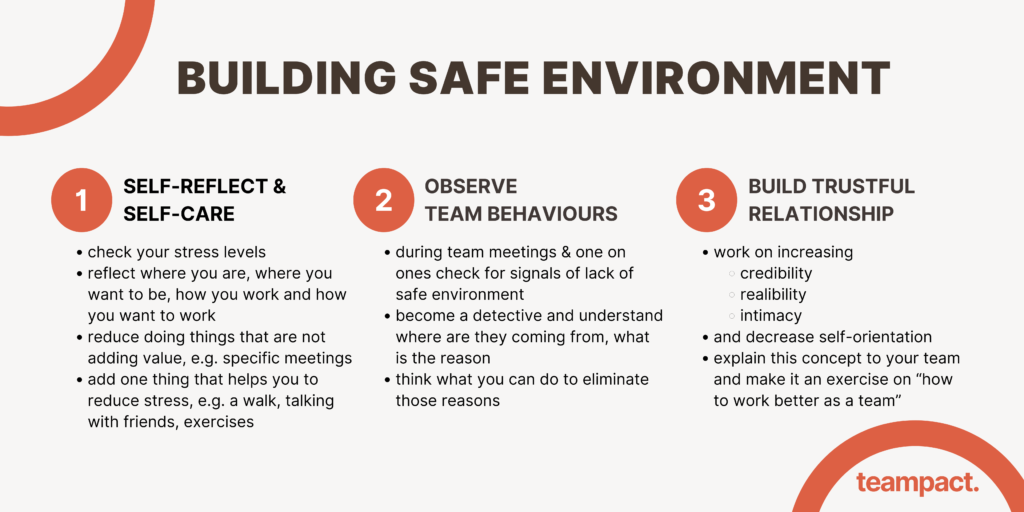Creating a safe environment is crucial for unlocking high team effectiveness, yet it’s often overlooked.
Here are three steps with practical tips to help you start building safety for your team right away.
STEP 1. Self-Awareness & Self-Care
Imagine entering a meeting already anxious and frustrated.
You’re juggling multiple tasks, dealing with a demanding boss, and facing constant complaints from your stakeholders. You feel more and more under pressure and more and more tired of everyone asking for something. And really… you don’t wanna hear more bad news that will make your day longer at work. You are stressed.
Do you know that entering the team meeting in such a state can negatively impact your team.
Here’s how:
- Your body language shows tension and makes others respond the same
- You joke about not wanting to hear more bad news so they share nothing
- You dominate the conversation, stifling team input so they stop sharing
- You ignore problems, asking the team to solve them without support so they give up
- You complain or express disappointment upon hearing bad news so they are afraid to share
- You dismiss requests for help, citing company limitations so they don’t believe anything can change
If any of this sounds familiar, you might be on the verge of burnout and it can be hard to give more to others if you don’t take care of yourself. (Check an article from Mayo Clinic to learn more about it)
But don’t you worry! There is good news here: you are now aware of it!
"You cannot create a safe environment for your team if you are in survival mode yourself"
Here are some strategies that helped me:
- Stop and Reflect: Assess where you are, where you want to go, and what you need to do.
- Focus on 1-2 Key Areas: one new healthy habit, one thing that I stop doing.
- Seek Support: Find people in similar situation. Seek mentors/coaches to guide you.
- Reorganise Your Calendar: Make time for what truly matters.
STEP 2. Team Behavior Awareness
In the rush of daily tasks, it’s easy to overlook your signals coming from the team. If you’re only seeking positive updates, you might miss critical issues. This can lead to last-minute crises and increased stress.
"If you expect everything to go smoothly and ignore the team's signals that things have changed, then you are not being a good leader"
Let’s take a look at the most common signals that your team does not have a safe environment:
- The team pretends all is well and doesn’t reveal challenges
- Individuals prefer to do things independently rather than engage in constructive conflict
- The problems accumulate and explode at the worst possible time
- Meetings are more stressful
- The team members don’t believe the leader can make any difference
- As a result of frustration, people go into their survival mode: aggression, apathy, avoidance
- There is no motivation for the team to make things better
- The team avoids mistakes, experiments, and takes only safe decisions that do not solve the existing problems
- Knowledge is disappearing as people leave the team
- Quality of the solution is lower
"Failure is not the only sign of an unsafe environment. Quite the contrary: it's lack of movement."
How can you start reading the signals right now?
Start with the upcoming team meeting.
Observe yourself and your team and ask yourself these questions:
- What is my attitude towards the team meeting?
- Do I wanna really learn the truth and help or do I just want to be updated about the good things?
- Who is participating and who is silent?
- How do people react when someone speaks?
- Do they share their perspective? Do they listen? Do they interrupt each other? Or do they just turn off the camera and do something else? What can be the reason?
- What emotions are visible in the meeting?
- Are people worried, easily irritated, apathetic, energetic, enthusiastic, bored, scared?
STEP 3. Bringing Trust to build a Safe Environment
Trust is the foundation of a safe environment.
It involves team members feeling fine with taking interpersonal risks, such as admitting mistakes or asking for help.
But how do we build trust? Isn’t it something that comes naturally? If yes, why do we suddenly forget it at work.
Let’s get hyper-practical about this very soft topic and use the trust equation introduced by David H. Maister, Charles H. Green and Robert M. Galford in their book “Trusted Advisor” (find more at Trusted Advisor website)

Let’s break it into very small practices you can start practising everyday!
The upper part of the equation relates to things that we want to increase.
1. Credibility
Credibility = the quality of being trusted and believed in. It’s related to our WORDS.
“I can trust what that person says about…”
Behaviours that increase credibility:
- know your things
- tell the truth & be transparent
- admit when you don’t know about something
- share real-life examples of your expertise
- ask smart questions that help others
2. Reliability
Reliability = the quality of performing consistently well. Related to our ACTIONS.
“I can depend on that person to…”
Behaviours that increase reliability:
- make small promises and deliver on time
- arrive on time to the meetings
- If you need to revoke a promise, do it immediately and replace it with one you can keep
3. Intimacy
Intimacy = sense of security that the person gets when interacting with you. Relates to EMOTIONS.
“I feel comfortable discussing this…”
Behaviours that increase intimacy:
- be vulnerable, admit your own mistakes
- react to people emotions, e.g.:
- “Oh really! Tell me more…”
- Listen actively to the other person and respect confidentiality
The bottom part of the equation tells us what we should decrease to build trust.
4. Self-orientation
That’s the tricky one! Especially that I told you at the beginning that you need to start with being self-aware and take care of yourself first. That’s still the case! The point is to not become an arrogant, “I know it all” person who believes that can do everything better and does not need others.
Self-orientation = a psychological orientation in which an individual wishes to have direct personal rewards regardless of the effects on others working with that individual. Relates to MOTIVES.
“I trust that this person cares about me too..”
Behaviours that reduce self-orientation:
- focus on the meeting (no phones, no laptops)
- ask open ended questions
- think out loud and involve others
- be curious

Creating space and starting small
Creating a safe environment doesn’t require a complete overhaul.
Start with small, manageable changes. Choose one thing to implement.
But… if you are like me, right now you are saying: “Come on! I can take more!”
Yep, you can 🙂 Just for how long?
It’s proven that the smaller the new habit, the more probable it is that you keep it.
So focus!
Choose one thing that you will do next.
If you’re feeling overwhelmed, focus on self-care first.
When you’re ready, shift to observing and adjusting team interactions.
Check on a weekly basis how that works, what changed.
Here’s a quick summary to help you choose:
- Become Self-Aware: Reflect on your stress levels and take care of yourself.
- Watch Team Behaviours: Observe and respond to team dynamics.
- Build Trust: Foster credibility, reliability, and intimacy while reducing self-orientation.

Enjoy your journey and take care of yourself!
I believe you have the power inside you to make the change you want to see!
Kasia from Teampact

